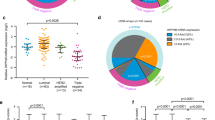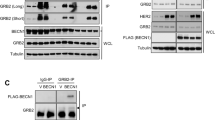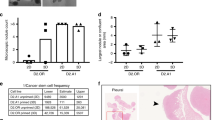Abstract
Beclin 1 is a haploinsufficient tumor suppressor that is decreased in many human tumors. The function of beclin 1 in cancer has been attributed primarily to its role in the degradative process of macroautophagy. However, beclin 1 is a core component of the vacuolar protein sorting 34 (Vps34)/class III phosphatidylinositoI-3 kinase (PI3KC3) and Vps15/p150 complex that regulates multiple membrane-trafficking events. In the current study, we describe an alternative mechanism of action for beclin 1 in breast cancer involving its control of growth factor receptor signaling. We identify a specific stage of early endosome maturation that is regulated by beclin 1, the transition of APPL1-containing phosphatidyIinositol 3-phosphate-negative (PI3P−) endosomes to PI3P+ endosomes. Beclin 1 regulates PI3P production in response to growth factor stimulation to control the residency time of growth factor receptors in the PI3P−/APPL+-signaling-competent compartment. As a result, suppression of BECN1 sustains growth factor-stimulated AKT and ERK activation resulting in increased breast carcinoma cell invasion. In human breast tumors, beclin 1 expression is inversely correlated with AKT and ERK phosphorylation. Our data identify a novel role for beclin 1 in regulating growth factor signaling and reveal a mechanism by which loss of beclin 1 expression would enhance breast cancer progression.
This is a preview of subscription content, access via your institution
Access options
Subscribe to this journal
Receive 50 print issues and online access
$259.00 per year
only $5.18 per issue
Buy this article
- Purchase on Springer Link
- Instant access to full article PDF
Prices may be subject to local taxes which are calculated during checkout







Similar content being viewed by others
References
Seaman MN, Marcusson EG, Cereghino JL, Emr SD . Endosome to Golgi retrieval of the vacuolar protein sorting receptor, Vps10p, requires the function of the VPS29, VPS30, and VPS35 gene products. J Cell Biol 1997; 137: 79–92.
Kametaka S, Okano T, Ohsumi M, Ohsumi Y . Apg14p and Apg6/Vps30p form a protein complex essential for autophagy in the yeast, Saccharomyces cerevisiae. J Biol Chem 1998; 273: 22284–22291.
Yue Z, Jin S, Yang C, Levine AJ, Heintz N . Beclin 1, an autophagy gene essential for early embryonic development, is a haploinsufficient tumor suppressor. Proc Natl Acad Sci USA 2003; 100: 15077–15082.
Qu X, Yu J, Bhagat G, Furuya N, Hibshoosh H, Troxel A et al. Promotion of tumorigenesis by heterozygous disruption of the beclin 1 autophagy gene. J Clin Invest 2003; 112: 1809–1820.
Cicchini M, Chakrabarti R, Kongara S, Price S, Nahar R, Lozy F et al. Autophagy regulator BECN1 suppresses mammary tumorigenesis driven by WNT1 activation and following parity. Autophagy 2014; 10: 2036–5.
Li Z, Chen B, Wu Y, Jin F, Xia Y, Liu X . Genetic and epigenetic silencing of the beclin 1 gene in sporadic breast tumors. BMC Cancer 2010; 10: 98.
Laddha SV, Ganesan S, Chan CS, White E . Mutational landscape of the essential autophagy gene BECN1 in human cancers. Mol Cancer Res 2014; 12: 485–490.
Dong M, Wan X-B, Yuan ZY, Wei L, Fan XJ, Wang T-T et al. Low expression of Beclin 1 and elevated expression of HIF-1α refine distant metastasis risk and predict poor prognosis of ER-positive, HER2-negative breast cancer. Med Oncol 2013; 30: 355.
Wang J, Pan X-L, Ding L-J, Liu D-Y, Lei D-P, Jin T . Aberrant expression of Beclin-1 and LC3 correlates with poor prognosis of human hypopharyngeal squamous cell carcinoma. PLoS ONE 2013; 8: e69038.
Karantza-Wadsworth V, Patel S, Kravchuk O, Chen G, Mathew R, Jin S et al. Autophagy mitigates metabolic stress and genome damage in mammary tumorigenesis. Genes Dev 2007; 21: 1621–1635.
Schu PV, Takegawa K, Fry MJ, Stack JH, Waterfield MD, Emr SD . Phosphatidylinositol 3-kinase encoded by yeast VPS34 gene essential for protein sorting. Science 1993; 260: 88–91.
Stephens L, Cooke FT, Walters R, Jackson T, Volinia S, Gout I et al. Characterization of a phosphatidylinositol-specific phosphoinositide 3-kinase from mammalian cells. Curr Biol 1994; 4: 203–214.
Gaullier JM, Simonsen A, D'Arrigo A, Bremnes B, Stenmark H, Aasland R . FYVE fingers bind PtdInsP. Nature 1998; 394: 432–433.
Patki V, Lawe DC, Corvera S, Virbasius JV, Chawla A . A functional PtdInsP-binding motif. Nature 1998; 394: 433–434.
Lindmo K, Stenmark H . Regulation of membrane traffic by phosphoinositide 3-kinases. J Cell Sci 2006; 119 (Pt 4): 605–614.
Kihara A, Noda T, Ishihara N, Ohsumi Y . Two distinct Vps34 phosphatidylinositol 3-kinase complexes function in autophagy and carboxypeptidase Y sorting in Saccharomyces cerevisiae. J Cell Biol 2001; 152: 519–530.
Itakura E, Kishi C, Inoue K, Mizushima N . Beclin 1 forms two distinct phosphatidylinositol 3-kinase complexes with mammalian Atg14 and UVRAG. Mol Biol Cell 2008; 19: 5360–5372.
Law JH, Habibi G, Hu K, Masoudi H, Wang MYC, Stratford AL et al. Phosphorylated insulin-like growth factor-i/insulin receptor is present in all breast cancer subtypes and is related to poor survival. Cancer Res 2008; 68: 10238–10246.
Resnik JL, Reichart DB, Huey K, Webster NJ, Seely BL . Elevated insulin-like growth factor I receptor autophosphorylation and kinase activity in human breast cancer. Cancer Res 1998; 58: 1159–1164.
Park HS, Jang MH, Kim EJ, Kim HJ, Lee HJ, Kim YJ et al. High EGFR gene copy number predicts poor outcome in triple-negative breast cancer. Mod Pathol 2014; 27: 1212–1222.
Miaczynska M, Pelkmans L, Zerial M . Not just a sink: endosomes in control of signal transduction. Curr Opin Cell Biol 2004; 16: 400–406.
Dutta D, Donaldson JG . Search for inhibitors of endocytosis: intended specificity and unintended consequences. Cell Logist 2012; 2: 203–208.
Platta HW, Stenmark H . Endocytosis and signaling. Curr Opin Cell Biol 2011; 23: 393–403.
Hayakawa A, Leonard D, Murphy S, Hayes S, Soto M, Fogarty K et al. The WD40 and FYVE domain containing protein 2 defines a class of early endosomes necessary for endocytosis. Proc Natl Acad Sci USA 2006; 103: 11928–11933.
Zoncu R, Perera RM, Balkin DM, Pirruccello M, Toomre D, De Camilli P . A phosphoinositide switch controls the maturation and signaling properties of APPL endosomes. Cell 2009; 136: 1110–1121.
Schenck A, Goto-Silva L, Collinet C, Rhinn M, Giner A, Habermann B et al. The endosomal protein Appl1 mediates Akt substrate specificity and cell survival in vertebrate development. Cell 2008; 133: 486–497.
Mitsuuchi Y, Johnson SW, Sonoda G, Tanno S, Golemis EA, Testa JR . Identification of a chromosome 3p14. 3-21.1 gene, APPL, encoding an adaptor molecule that interacts with the oncoprotein-serine/threonine kinase AKT2. Oncogene 1999; 18: 4891.
Lee M-H, Klein RL, El-Shewy HM, Luttrell DK, Luttrell LM . The adiponectin receptors AdipoR1 and AdipoR2 activate ERK1/2 through a Src/Ras-dependent pathway and stimulate cell growth. Biochemistry 2008; 47: 11682–11692.
Jones RB, Gordus A, Krall JA, MacBeath G . A quantitative protein interaction network for the ErbB receptors using protein microarrays. Nature 2006; 439: 168–174.
Ryu J, Galan AK, Xin X, Dong F, Abdul-Ghani MA, Zhou L et al. APPL1 potentiates insulin sensitivity by facilitating the binding of IRS1/2 to the insulin receptor. Cell Rep 2014; 7: 1227–1238.
Shravage BV, Hill JH, Powers CM, Wu L, Baehrecke EH . Atg6 is required for multiple vesicle trafficking pathways and hematopoiesis in Drosophila. Development 2013; 140: 1321–1329.
Kametaka S, Matsuura A, Wada Y, Ohsumi Y . Structural and functional analyses of APG5, a gene involved in autophagy in yeast. Gene 1996; 178: 139–143.
Leonard D, Hayakawa A, Lawe D, Lambright D, Bellvé KD, Standley C et al. Sorting of EGF and transferrin at the plasma membrane and by cargo-specific signaling to EEA1-enriched endosomes. J Cell Sci 2008; 121 (Pt 20): 3445–3458.
Dillon RL, Marcotte R, Hennessy BT, Woodgett JR, Mills GB, Muller WJ . Akt1 and akt2 play distinct roles in the initiation and metastatic phases of mammary tumor progression. Cancer Res 2009; 69: 5057–5064.
Arboleda MJ, Lyons JF, Kabbinavar FF, Bray MR, Snow BE, Ayala R et al. Overexpression of AKT2/protein kinase Bbeta leads to up-regulation of beta1 integrins, increased invasion, and metastasis of human breast and ovarian cancer cells. Cancer Res 2003; 63: 196–206.
Gao J, Aksoy BA, Dogrusoz U, Dresdner G, Gross B, Sumer SO et al. Integrative analysis of complex cancer genomics and clinical profiles using the cBioPortal. Sci Signal 2013; 6: pl1.
Cerami E, Gao J, Dogrusoz U, Gross BE, Sumer SO, Aksoy BA et al. The cBio cancer genomics portal: an open platform for exploring multidimensional cancer genomics data. Cancer Discov 2012; 2: 401–404.
Lőrincz P, Lakatos Z, Maruzs T, Szatmári Z, Kis V, Sass M . Atg6/UVRAG/Vps34-containing lipid kinase complex is required for receptor downregulation through endolysosomal degradation and epithelial polarity during Drosophila wing development. Biomed Res Int 2014; 2014: 851349.
Lawe DC, Chawla A, Merithew E, Dumas J, Carrington W, Fogarty K et al. Sequential roles for phosphatidylinositol 3-phosphate and Rab5 in tethering and fusion of early endosomes via their interaction with EEA1. J Biol Chem 2002; 277: 8611–8617.
Er EE, Mendoza MC, Mackey AM, Rameh LE, Blenis J . AKT facilitates EGFR trafficking and degradation by phosphorylating and activating PIKfyve. Sci Signal 2013; 6: ra45.
Liang C, Feng P, Ku B, Dotan I, Canaani D, Oh B-H et al. Autophagic and tumour suppressor activity of a novel Beclin1-binding protein UVRAG. Nat Cell Biol 2006; 8: 688–699.
Knævelsrud H, Ahlquist T, Merok MA, Nesbakken A, Stenmark H, Lothe RA et al. UVRAG mutations associated with microsatellite unstable colon cancer do not affect autophagy. Autophagy 2010; 6: 863–870.
Liang C, Lee J-S, Inn K-S, Gack MU, Li Q, Roberts EA et al. Beclin1-binding UVRAG targets the class C Vps complex to coordinate autophagosome maturation and endocytic trafficking. Nat Cell Biol 2008; 10: 776–787.
Wei Y, Zou Z, Becker N, Anderson M, Sumpter R, Xiao G et al. EGFR-mediated Beclin 1 phosphorylation in autophagy suppression, tumor progression, and tumor chemoresistance. Cell 2013; 154: 1269–1284.
Wang RC, Wei Y, An Z, Zou Z, Xiao G, Bhagat G et al. Akt-mediated regulation of autophagy and tumorigenesis through Beclin 1 phosphorylation. Science 2012; 338: 956–959.
Navaroli DM, Bellvé KD, Standley C, Lifshitz LM, Cardia J, Lambright D et al. Rabenosyn-5 defines the fate of the transferrin receptor following clathrin-mediated endocytosis. Proc Natl Acad Sci 2012; 109: E471–E480.
Hayakawa A, Hayes SJ, Lawe DC, Sudharshan E, Tuft R, Fogarty K et al. Structural basis for endosomal targeting by FYVE domains. J Biol Chem 2004; 279: 5958–5966.
Pankratz SL, Tan EY, Fine Y, Mercurio AM, Shaw LM . Insulin receptor substrate-2 regulates aerobic glycolysis in mouse mammary tumor cells via glucose transporter 1. J Biol Chem 2008; 284: 2031–2037.
Acknowledgements
This work was supported by National Institute of Health (NIH) grants CA142782 and CA177167 (LMS), DK60564 (SC) and CA159314 (EHB). We thank Lawrence M Lifshitz and Clive Standley of the UMass Biomedical Imaging Group for their contributions to the programs used to analyze the TESM data. We thank Sha Zhu for assistance with cloning, Usha Acharya for assistance with the PI3P lipid measurements and Chung-Cheng Hsieh for statistical advice.
Author information
Authors and Affiliations
Corresponding author
Ethics declarations
Competing interests
The authors declare no conflict of interest.
Additional information
Supplementary Information accompanies this paper on the Oncogene website
Supplementary information
Rights and permissions
About this article
Cite this article
Rohatgi, R., Janusis, J., Leonard, D. et al. Beclin 1 regulates growth factor receptor signaling in breast cancer. Oncogene 34, 5352–5362 (2015). https://doi.org/10.1038/onc.2014.454
Received:
Revised:
Accepted:
Published:
Issue Date:
DOI: https://doi.org/10.1038/onc.2014.454
This article is cited by
-
Advances in the study of autophagy in breast cancer
Breast Cancer (2024)
-
SRSF1 inhibits autophagy through regulating Bcl-x splicing and interacting with PIK3C3 in lung cancer
Signal Transduction and Targeted Therapy (2021)
-
Autophagy as a modulator of cell death machinery
Cell Death & Disease (2020)
-
Estrogen receptor β inhibits breast cancer cells migration and invasion through CLDN6-mediated autophagy
Journal of Experimental & Clinical Cancer Research (2019)
-
PI3K isoforms in cell signalling and vesicle trafficking
Nature Reviews Molecular Cell Biology (2019)



